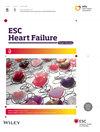Clinical characteristics and outcomes of adults with acute heart failure in a South African teaching hospital
Abstract
Aims
In sub-Saharan Africa (SSA), the clinical profile and in-hospital outcomes of adults with acute heart failure (HF) based on left ventricular ejection fraction (LVEF) categories are unknown. This study aimed to describe the prevalence and clinical characteristics of patients admitted with acute HF based on LVEF categories and their association with in-hospital outcomes.
Methods
Four hundred six consecutive patients with acute HF were enrolled in this prospective study between February and November 2023. The patients were stratified into three categories: HF with reduced ejection fraction (HFrEF), HF with mildly reduced ejection fraction (HFmrEF) and HF with preserved ejection fraction (HFpEF). The primary outcome measure was all-cause in-hospital mortality. The prevalence and outcomes of various LVEF phenotypes were evaluated in adult patients with acute HF.
Results
The mean age of the patients was 54.94 ± 15.83 years, of whom 207 (51%) were female (P = 0.004). Two hundred fifty-seven (63.3%) patients had HFrEF, 62 (15.3%) had HFmrEF, and 87 (21.4%) had HFpEF. Patients with HFpEF were older and predominantly female and had a higher median global longitudinal score and lower N-terminal pro-B-type natriuretic peptide (NT-proBNP) levels (P < 0.001). The all-cause in-hospital mortality was 3.4% [95% confidence interval (CI): 2.0–6.0] without significant variation across LVEF phenotypes (P = 0.70). In the multivariable model after adjusting for age and sex, higher C-reactive protein levels [odds ratio (OR): 1.02; 95% CI: 1.00–1.03; P = 0.009], elevated neutrophil–lymphocyte ratio (OR: 1.15; 95% CI: 1.03–1.29; P = 0.012), elevated serum potassium (OR: 3.41; 95% CI: 1.23–9.43; P = 0.018), moderate aortic regurgitation (AR) (OR: 12.80; 95% CI: 1.12–101.29; P = 0.016) and severe AR (OR: 34.49; 95% CI: 3.77–353.47; P = 0.002) were observed. Low diastolic blood pressure was associated with a reduced mortality risk (OR: 0.94; 95% CI: 0.89–0.99; P = 0.045).
Conclusions
In our study, HFrEF was the predominant phenotype, and each phenotype exhibited distinct clinical and biomarker profiles. All-cause in-hospital mortality was low and did not differ significantly across the phenotypes. Independent predictors of mortality included markers of inflammation, electrolyte imbalance and moderate-to-severe AR. These findings highlight the need for targeted risk stratification and management strategies to improve the outcomes in this population.


 求助内容:
求助内容: 应助结果提醒方式:
应助结果提醒方式:


